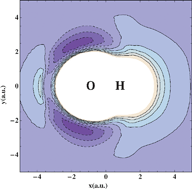Study of the C(3P) + OH(X2Π) → CO(a3Π) + H(2S) reaction: fully global ab initio potential energy surfaces of the 12A″ and 14A″ excited states and non adiabatic couplings
Abstract
We report in this paper ab initio calculations of the potential energy surfaces (PESs) for the four states involved in the C(3P) + OH(X2Π)→ CO(a3Π) + H(2S) reaction as well as numerical values of the rate constants for two states, 12A″ and 14A″ which show no potential barriers during the reaction. In contrast, the other two states, i.e. the 22A′ and 14A′ states, are energetically not favourable to the reaction as the first state has a potential barrier of 0.2 eV in the entrance channel and the former one presents long range potential wells and repulsive wall for carbon approaches near OH. The ab initio calculations of the potential energies have been performed at the multireference internally contracted single and double configuration interaction (MR-SDCI) level corrected for its size-inconsistency by the Davidson method (+Q), and using Dunning aug-cc-pVQZ atomic basis sets. Global PESs have then been generated for the two A″ states from an analytical fit obtained with the reproducing kernel Hilbert space method on a large number of ab initio points located on a regular grid in Jacobi coordinates. The title reaction is much less exoergic (−0.41 eV) than the one on the ground state and each state presents many extrema (four for the 12A″ and eight for the 14A″). From the configuration and energy of these extrema, different reaction mechanisms are suggested depending on the collision energy. Quasi-classical trajectory calculations on these global PESs have been used to estimate reactive cross-sections as functions of the collision energy and thermal rate constant as a function of the temperature. The weighted rate constant for each state, i.e. including the spin–orbit population factor, increases with the temperature contrary to the ground state one. Nevertheless, a decreasing behaviour with the temperature remains between 10 and 500 K if we consider the total rate constant of C(3P) + OH(X2Π), sum of the three reactive states rate constants.


 Please wait while we load your content...
Please wait while we load your content...